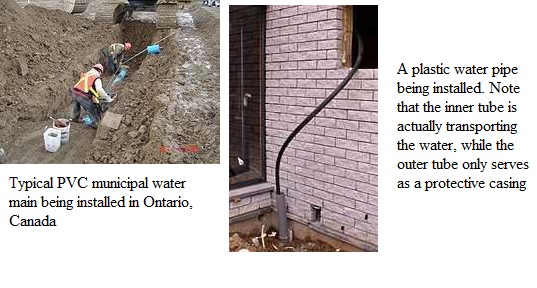Chapter: Environmental Engineering : Collection and conveyence System of water
Water Network Maintenance

WATER
NETWORK MAINTENANCE
Water supply networks usually represent the majority
of assets of a water utility. Systematic documentation of maintenance works
using a Computerized Maintenance Management System is a key to a successful
operation of a water utility.
Water
pipe
Water pipes are
pipes or tubes, frequently made of polyvinyl chloride (PVC/uPVC), ductile iron,
steel, cast iron, polypropylene, polyethylene, or copper, that carry
pressurized and treated fresh water to buildings (as part of a municipal water
system), as well as inside the building.
Pipe
vs. tube
The difference between pipe and tube is simply in
the way it is sized. PVC pipe for plumbing applications and galvanized steel
pipe for instance, are measured in IPS (iron pipe size). Copper tube, CPVC, PeX
and other tubing is measured nominally, which is basically an average diameter.
These sizing schemes allow for universal adaptation of transitional fittings.
For instance, 1/2" PeX tubing is the same size as 1/2" copper tubing.
1/2" PVC on the other hand is not the same size as 1/2" tubing, and
therefore requires either a threaded male or female adapter to connect them.
When used in agricultural irrigation, the singular form "pipe" is
often used as a plural.
Piping is available in rigid "joints",
which come in various lengths depending on the material. Tubing, in particular
copper, comes in rigid hard tempered "joints" or soft tempered
(annealed) rolls. PeX and CPVC tubing also comes in rigid "joints" or
flexible rolls. The temper of the copper, that is whether it is a rigid
"joint" or flexible roll, does not affect the sizing.
The thicknesses of the water pipe and tube walls can
vary. Pipe wall thickness is denoted by various schedules. Pipe wall thickness
increases with schedule, and is available in schedules 20, 40, 80, and higher
in special cases. The schedule is largely determined by the operating pressure
of the system, with higher pressures commanding greater thickness. Copper
tubing is available in four wall thicknesses: type DWV (thinnest wall; only
allowed as drain pipe per UPC), type 'M' (thin; typically only allowed as drain
pipe by IPC code), type 'L' (thicker, standard duty for water lines and water
service), and type 'K' (thickest, typically used underground between the main
and the meter). Because piping and tubing are commodities, having a greater
wall thickness implies higher initial cost. Thicker walled pipe generally
implies greater durability and higher pressure tolerances.
Wall thickness does not affect pipe or tubing size.
1/2" L copper has the same outer diameter as 1/2" K or M copper. The
same applies to pipe schedules. As a result, a slight increase in pressure
losses is realized due to a decrease in flowpath as
wall thickness is increased. In other words, 1 foot of 1/2" L copper has
slightly less volume than 1 foot of 1/2 M copper.[citation needed]
Demand for copper
products have fallen due to the dramatic increase in the price of copper,
resulting in increased demand for alternative products including PEX and
stainless steel.
Related Topics